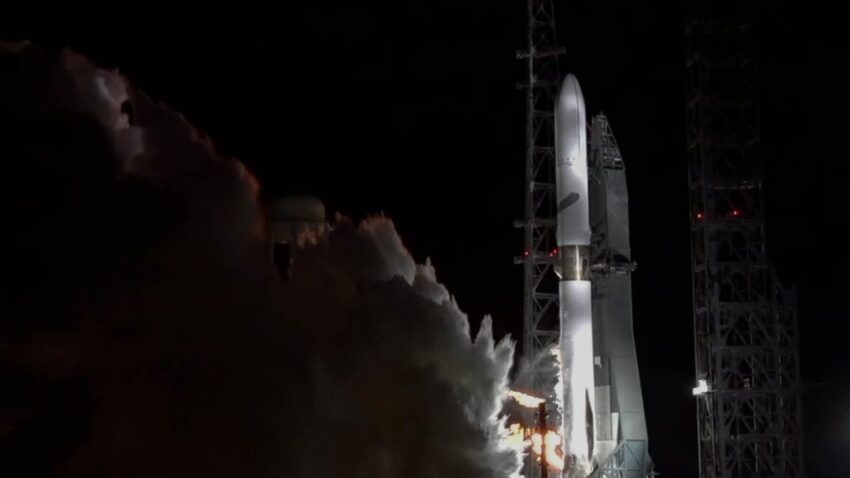
new glenn rocket has clear path to The successful test-firing of Blue Origin’s New Glenn rocket marks a significant milestone in its journey toward its second flight, paving the way for a potential launch next month.
new glenn rocket has clear path to
Overview of the Test-Firing
On Thursday night, Blue Origin conducted a crucial test-firing of the New Glenn rocket’s seven BE-4 main engines at Cape Canaveral Space Force Station in Florida. The engines ignited at 9:59 PM EDT (01:59 UTC Friday) and burned for a duration of 38 seconds while the rocket remained securely on the ground. This event was shared via a social media post by Blue Origin, highlighting the importance of this milestone in the rocket’s development.
Significance of the Test
The hold-down firing of the first-stage engines represents the final major test before the New Glenn rocket is cleared for launch. This test is critical as it assesses the performance and reliability of the rocket’s engines under conditions that simulate a launch without actually lifting off. Successful completion of this test indicates that the rocket is ready for the next phase of its development.
Prior to this, Blue Origin had already conducted successful test-firings of the rocket’s second-stage engines. These tests are essential for ensuring that all components of the rocket function as intended, and they contribute to the overall safety and reliability of the launch vehicle.
Technical Aspects of the New Glenn Rocket
The New Glenn rocket is designed to be a heavy-lift launch vehicle capable of carrying a variety of payloads into orbit. Its architecture includes:
- Two-Stage Configuration: The rocket features a two-stage design, with the first stage powered by seven BE-4 engines and the second stage utilizing a single BE-4 engine.
- Reusable Components: One of the key innovations of the New Glenn rocket is its reusability. The first stage is designed to return to Earth for refurbishment and reuse, which could significantly reduce the cost of access to space.
- Payload Capacity: The New Glenn is expected to have a payload capacity of up to 45 metric tons to low Earth orbit (LEO), making it one of the most powerful rockets currently in development.
BE-4 Engine Technology
The BE-4 engines are a critical component of the New Glenn rocket’s first stage. Developed by Blue Origin, these engines utilize a staged combustion cycle, which is known for its efficiency and performance. The BE-4 engines are designed to burn liquefied natural gas (LNG) and liquid oxygen (LOX), making them a more environmentally friendly option compared to traditional rocket fuels.
The development of the BE-4 engine has been a significant undertaking for Blue Origin, and its successful performance in the recent test-firing is a positive indicator for the company’s future launch plans.
Timeline and Future Launch Plans
While Blue Origin has not officially announced a specific launch date, sources indicate that the New Glenn rocket could be ready for liftoff as soon as November 9. This timeline aligns with Blue Origin’s broader goals of establishing a reliable launch cadence for the New Glenn rocket.
The upcoming launch is expected to be a pivotal moment for Blue Origin, as it seeks to solidify its position in the competitive space launch market. The company has been working diligently to develop the New Glenn rocket, and a successful launch would demonstrate the viability of its heavy-lift capabilities.
Market Context
The space launch industry has seen significant growth in recent years, with numerous companies vying for a share of the market. Blue Origin, founded by Jeff Bezos, is one of several players in this rapidly evolving landscape. Other notable competitors include SpaceX, United Launch Alliance (ULA), and Northrop Grumman, each of which has its own heavy-lift launch vehicles.
SpaceX, in particular, has established a strong foothold in the market with its Falcon 9 and Falcon Heavy rockets. The success of these vehicles has set a high bar for other companies, including Blue Origin, to meet in terms of reliability, cost-effectiveness, and launch frequency.
Stakeholder Reactions
The recent test-firing has elicited positive reactions from various stakeholders in the aerospace community. Industry experts and analysts view the successful test as a promising sign for Blue Origin’s future endeavors. The ability to conduct a successful hold-down firing is often seen as a precursor to a successful launch, and many are optimistic about the company’s trajectory.
Investors and potential customers are also closely monitoring Blue Origin’s progress. A successful launch of the New Glenn rocket could attract new contracts and partnerships, further enhancing the company’s reputation in the industry. The ability to demonstrate reliable heavy-lift capabilities is crucial for securing contracts with government agencies, commercial satellite operators, and other entities looking to access space.
Challenges Ahead
Despite the positive developments, Blue Origin faces several challenges as it moves closer to the launch of the New Glenn rocket. The competitive landscape of the space launch industry means that the company must not only deliver a successful launch but also establish a reliable launch schedule to attract customers.
Additionally, Blue Origin has faced delays in the development of the BE-4 engine, which has been a point of concern for some stakeholders. Ensuring that the engines perform reliably in future tests and during the actual launch will be critical for the company’s credibility and future success.
Conclusion
The successful test-firing of the New Glenn rocket’s BE-4 engines is a significant step forward for Blue Origin as it prepares for its second flight. With a potential launch date as early as November 9, the company is poised to make a substantial impact in the heavy-lift launch market. As the aerospace industry continues to evolve, Blue Origin’s ability to navigate challenges and deliver reliable launch services will be crucial for its long-term success.
As the countdown to the launch begins, all eyes will be on Blue Origin to see if it can meet the expectations set by its recent achievements and establish itself as a key player in the competitive landscape of space exploration.
Source: Original report
Was this helpful?
Last Modified: November 1, 2025 at 2:38 am
0 views















